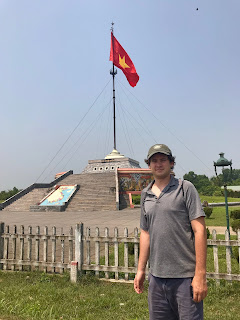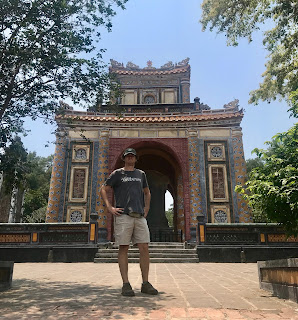DMZ Tour and the Ancient Capital of Hue
Halfway between
Phong Nha National Park and our next city, Hue, is Vietnam’s former Demilitarized
Zone, known as the “DMZ”. This five kilometer strip of land on either side
of the Ben Hai River served an important role in Vietnam’s military history. Established
as part of the 1954 peace agreement at the end the French Indochina War, it was
a buffer between the divided North and South and later was the site of many
bloody battles during the American-Vietnam War in the 60’s and 70’s. Few of the
area’s original bases and bunkers are still around, but visitors are able to
tour the Vinh Moc Tunnels where a community of Vietnamese hid underground
during the war, as well as a cemetery and museum. Matt and I booked a special
tourist bus that passed through the DMZ and stopped at these sites before
continuing onto Hue.
We pulled up to
the Vinh
Moc Tunnels, and a local guide told our group of 12 tourists about the
development of the elaborate shelter system, and how over 60 families lived
their lives for almost six years underground while bombs rained down above. I
was most impressed to hear that the three-story underground structure was built
without the insight of any engineers or architects; the local people built the
tunnels in the dark of night to avoid detection. The tunnel system was complete
with kitchens, bedrooms, and even a maternity room where 17 children were born
over the course of the war years. Our group began to descend into the tunnels
and all of the sudden I was overcome with the feeling of extreme
claustrophobia. The underground pathway was dark and small, and I knew it was
nonsensical to have any concerns but knowing that a dark labyrinth of small
passageways lay ahead was just too much to handle. I had to exit the tunnels
almost immediately and Matt joined me above ground as we waited for the rest of
the group to emerge. I was disappointed in myself for having such a reaction.
It was a bummer not to be able to see the tunnels after hearing so much about
them.
Descending into the Vinh Moc Tunnels before turning right back around.
Next our group
stopped at a DMZ museum complete with many photographs of the war years, a
statue of Ho Chi Minh, and life-size dioramas of Vietnamese and American
soldiers depicting scenes during the war. Interestingly the museum housed tools
that the Vietnamese used during the war and were made from American downed
planes. For example, a metal operating table was crafted from the wreckage of
B-52 plane that crashed in the area. There were also many unexploded ordinances
and pictures of people whose bodies had been ravaged by land mines after the
war—a big post-war challenge to this day. The museum provided information
primarily in Vietnamese but the artifacts were still very impactful to see. We
ended our DMZ tour with a walk across the Ben Hai River from North Vietnam to
South Vietnam before piling onto the bus and continuing to Hue. While the
tunnels did not work out too well for me, the experience of simply seeing the
DMZ area and reimagining what had gone on decades ago was very powerful.
War memorial outside of the museum in the DMZ.
Ho Chi Minh statue and quote at the DMZ museum.
Hue (pronounced more like “way”)
is an ancient, central Vietnamese city of about 455,000 people. It served as
the capital of Dang Trong Kingdom in the 1700s and the Nguyen Dynasty from 1802
until as recently as 1945. The main attraction in Hue is the Nguyen Dynasty’s
citadel complete with a moat and thick stone walls—similar to the structure of
Chiang Mai. Inside the citadel are classic Vietnamese style buildings that served
as homes, libraries, gardens, assembly halls, and more during the 19th
and 20th centuries. This area is called the “Imperial
City” with its many palaces and shrines and has been designated as a UNESCO
World Heritage Site. Unfortunately due to Hue’s strategic location in Vietnam,
the historic city—including the citadel and all its important cultural
landmarks—was the site of one of the longest and deadliest battles in the
entire American-Vietnam War. Hue was mentioned frequently in the Ken Burns
documentary that Matt and I watched before coming to this country, so we were
very interested to see how it looked.
I must admit—the situation
was grim. Over 75% of the ancient buildings in the citadel had been destroyed
and there is an active restoration project ongoing to salvage what is left and re-create
the Imperial City to its former state. Bullet holes pepper many of the brick
walls and what is left of many of historic structures are piles of rubble. The internationally-funded
restoration effort has led to the re-opening of a few key sites including the
Ngo Mon Gate through which you enter the facility, the Palace of Supreme
Harmony, the Royal Reading Room, beautifully-manicured gardens with dozens of bonsai
trees, and two residences of former royal families. Small exhibits are scatted
across the complex with photographs of the area before and after the war as
well as details related to the ongoing conservation efforts. We enjoyed walking
around the Imperial City for a couple of hours and hope to return when the
restoration project is complete.
At the Ngo Mon Entry Gate.
Bullet holes like these dotted the walls throughout the complex.
One of the restored buildings in the Imperial City.
Exiting the citadel through an ornate-looking gate.
Hue is also known
for its wide and shimmering Perfume River that cuts
through the city. One evening Matt and I enjoyed drinks at a café next to the
river and the water shone with beautiful reflections of colorful Vietnamese
lanterns and the buildings along its shore. Many tourists hire boats to travel
down the Perfume River and visit a smattering of tourist attractions, but Matt
and I didn’t feel it was worth the money to take a boat so we used “Grab” (Vietnam’s
Uber equivalent) to summon cabs that took us around town by road. In addition
to the Imperial City, we visited the Thien Mu Pagoda, or Pagoda of the
Celestial Lady, a seven-tiered Buddhist temple that is often used as a
symbol to represent the city of Hue. Built in 1601, the pagoda sits on the shore
of the Perfume River and also has many shrines, statues, and gardens
surrounding the main building itself. One unexpected relic at the pagoda was
the old blue car that the Buddhist monk Thich
Quang Duc used to drive himself to Saigon in 1963 where he proceeded to burn
himself to death to protest the government’s discrimination against Buddhists. This
dark moment in history was also covered in the Ken Burns Vietnam War
documentary, so it was fresh in our minds and somewhat haunting to see the car
in person. You can actually see the car in the background of this
gruesome photo from the incident.
The Perfume River and its many boats to transport tourists.
Buddhist monk Thich Quang Duc drove this car to his self-immolation.
Pagoda of the Celestial Lady, an iconic symbol of Hue.
Matt and I
concluded our historical tour of Hue at the Tomb
of Tu Duc, constructed in the mid-1800s. More of a temple complex than a
stand-alone tomb, the area contains a pavilion, lotus pond, and multiple tombs
for Emperor Tu Duc and his wife. The leader oversaw the building of the complex
and actually seemed to use it as a retreat and hang-out spot for himself and
his over 100 wives and concubines during its construction. He wrote his own
epitaph inscribed in stone, which is erected close to his tomb on the compound.
A great irony, however, is that after he died the man was buried in a secret
location somewhere in Hue but not at the Tomb of Tu Duc itself! To this day no
one knows where he is buried, primarily because the 200 workers who carried out
the Emperor’s burial were beheaded immediately after the act in order to keep
the location a permanent mystery. It is truly a wild and gory tale that we did
not know about until visiting the tomb! We enjoyed walking around the complex
and taking in its beautiful landscaping and architecture. It was an extremely
hot day, however, so we made it a speedy visit and returned to our hotel to cool
down for the rest of the afternoon.
Inside this pavilion was a large stone inscribed with Emperor Tu Duc's epitaph.
Pond and pavilion inside the Tu Duc Tomb complex.
Jackfruit trees were planted throughout the complex and we've been seeing them all over Vietnam! I captured a photo of this very productive tree. It reminded me of the cocoa trees I saw in Côte d'Ivoire!
Aside from Hue’s
historic value as a tourist destination, the city itself is filled with cute restaurants,
coffee shops, clothing stores, and a surprisingly-active nightlife. Many young
people were walking around town day and night; there seems to be a market for recreational
drugs considering that friendly men on motorbikes consistently approached us asking
if we wanted to purchase any marijuana. While we repeatedly declined those offers,
Matt and I feasted on several memorable meals and coconut coffees in Hue, and
spent both evenings hanging out at a fancy, recently-built shopping mall. We
saw two movies while we were there—Dumbo (fairly depressing and not so enjoyable)
and Shazam (light-hearted and entertaining). The theater was brand-new and very
impressive with its plush, red-carpeted lounge area and assigned seating
methodology. Tickets cost just $2 each per movie, and at that rate it makes for
a great, air-conditioned and mosquito-free indoor activity to do after a long
day of walking in the sun!
Sushi boat at a Japanese restaurant in Hue.
Yet another coconut coffee for Matt! This one had sugar-covered toasted coconut chips sprinkled on top.
One of the cute cafés we dined at in Hue. This one called "Nook" was tucked away in a quiet alley.
"I Love Hue" sign in a riverside park.

















Comments
Post a Comment